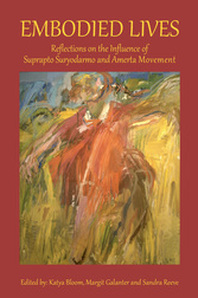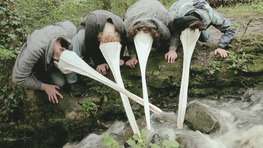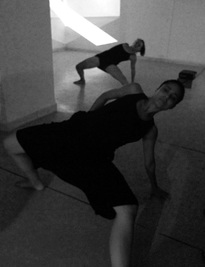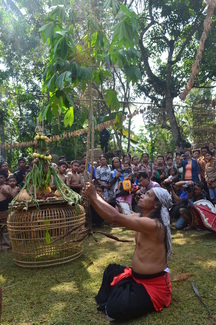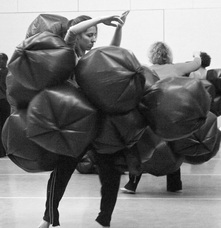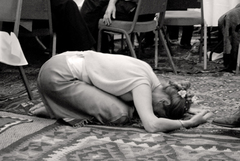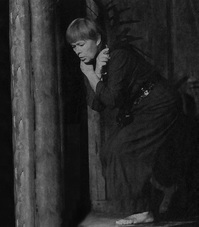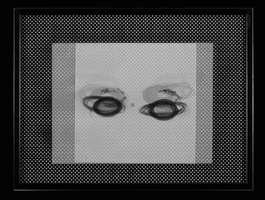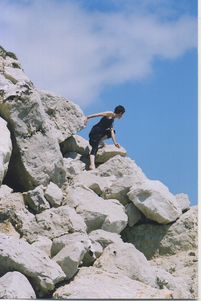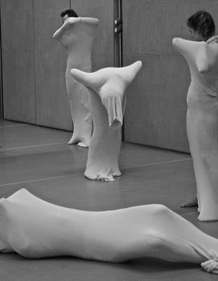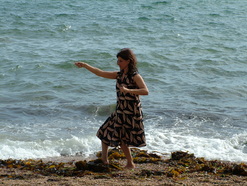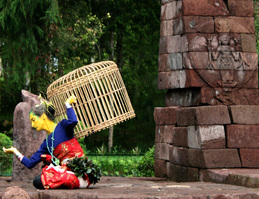Embodied Lives ~ Contents and AuthorsPresence
Beate Stühm writes about movement from inside the experience, from moment to moment. She reflects on awareness, creativity and acceptance - on a journey of growth. Amerta movement and archaeology: excavation without digging Keith Miller looks at themes like time, place, layers, memory and the Amerta techniques ‘living measurement’, ‘finding position and point of view’ and 'Circle, Oval and Square', in exploring links between movement and archaeology. Cultural Aspects of the Movement Work Christina Stelzer, rather than talking about her own work, highlights and explores three aspects of the Javanese culture that she sees as central to Amerta Movement: waiting, hearing the world and respect. Amerta and Tibetan Buddhism: Beyond the Cushion Monika Förster describes 'hitting yourself with your mind', 'mind as an ally', 'bowing towards daily life', 'being seen', 'giving awareness without creating stagnation'... and other practices. See the visual flow web of chapters. The Eye of the Hand: Embodied Filmmaking as Movement Practice Steve Hopkins explores movement practice on film through the lens of his work with 3m (meditation, movement and movie) groups in movement workshops, and working with Prapto on film. A Dog Practising ‘Talking Body’ José Mulder van de Graaf explores the concept of a ‘language of feelings’, that enables us to understand and to express, even to enhance knowledge in another way… to ‘comprehend’ the space, to ‘acknowledge’ nature while it constantly changes, and, last not least, to recognise our self. Make Less the Hoping Sandra Reeve shows how Prapto's teaching about the mudras associated with the four sides of Borobudur temple can be applied in daily life and ritual and then looks at how movement guiding works. Additional Resources. Touching Forgotten Realities: A practice of detecting the happening Bettina Mainz investigates what she describes as the forces of critique, freedom and reconciliation in her life as a movement teacher and dancer. The Echo of Life: Developing Resonance Through Amerta Movement Daniela Coronelli shows how the practice of Amerta Movement has helped her to develop her profession as a Shiatsu and Seiki practitioner and teacher, utilising direct embodied experience of Resonance and Mindfulness, in her contact with clients and students. I Always Do Three Things Shantam Zohar explains and discusses the Amerta practices of flowering, channeling and semadi [meditation]. See the visual flow web of chapters. A Presencing Dial Margit Galanter says presence is a basis, filter and medium for how we are in a situation, interacting with one another, the environment and our felt senses. This mobility in presence can be gauged on a dial - ranging from 'as loud as brightness that enjoys being seen' to 'as quiet as a happy shadow'. Amerta Movement and Somatic Costume: Sourcing the Ecological Image Sally Dean describes how Prapto's literal, imaginal and metaphorical use of the terms 'costume' and clothing' have informed her ongoing research into using 'somatic costumes' in performance. Crystallization-performance: a new expression in its own right Lise Lavelle looks at the crystallizations offered in Amerta movement work. "The story... was already there locked up in my muscles and in the Valley, waiting to be found... it is not I who creates, rather something or someone does it for me. I am just a page in a big book. I have experienced that... there are structures and whole dance dramas tied up deep inside our bodies." Additional Resources. Being and Doing in the Wild Garden: Movement psychotherapy in an East German psychosomatic hospital Susanne Tümpel picks the themes of Oneness and Separateness, Organism and Organization in exploring the application of Amerta Movement in her individual and group psychotherapy work. 'Mantra Gerak' / Movement Mantra Agus Bima Prayitna explains the practice of embodying movement and sound in oneself, art, culture, nature, society and the mystical. See the visual flow web of chapters. The Musical Portal Inspired by Prapto’s injunction “you do not yet know your hearing has language” Tim Jones mixes storytelling with an inquiry into conversation, relationship, the nature of sound and song worlds, finishing with a ‘text sound composition’ for the reader to explore. Near the Unknown Franca Fubini explores Prapto's ideas of Dreamworld and Realityworld and her application of Amerta Movement to a practice known as Social Dreaming. Family: The Field of Blossoming Una Nicholson learnt from Prapto’s teaching that family is a dynamic and creative vessel. Building on his idea of the family as a dynamic generator, a source of regeneration and a place to practise the art of everyday living and being, she describes how adopting an ‘attitude of family’ can reveal a field in which we are deeply connected and where things get done easily and collaboratively, where the individual and 'the whole family' can flourish. The Infant’s Language Katya Bloom describes her interest in the residual effects of our earliest pre-verbal experiences on later development. "Conferring with infants" in a Neonatal Intensive Care Unit, she describes how we can disrupt long-installed habits through movement, develop greater empathy and common ground with others, and recognize ourselves as part of the ‘garden’ of all life. See the visual flow web of chapters. 'Going out of the situation' and 'Stop, don’t follow that, walk!': Two movement themes that support my work with children Regula Nell presents movement strategies she practises as a movement teacher, Feldenkrais practitioner and psychomotor-therapist. Amerta Movement and Autism: Therapy, Communication, Collaboration and Art Sean Williams, a Developmental Therapist, Educator and Play Therapist, describes how Prapto opened a door to a totally new understanding of his clients helped him to see how working with people on the spectrum is an act of collaborative communication – "creating something together that enriches all of our lives." “Find Your Position”: An Embodied Approach to Movement and Daily Life Susan Bauer explores Prapto’s theme of ‘finding your position’, a means of centering within oneself through embodied presence that opens us to the creative energies of life. She further highlights links between his practice and that of both Authentic Movement and her own form called 'Moving-from-Within'. Body Body: A movement practitioner’s journey with Amerta Movement Helen Poynor explores how the dual lineage of Prapto’s and Anna Halprin’s approaches to movement relate to her own practice. Themes include: non-stylised movement, moving in the environment, working with feelings and the role of the mind. Ever-speaking being Michael Dick uses the lenses of 'permeability' and 'presence' (two fundamental human potentials) as an actor trainer - which he calls developing the human instrument for performing arts. Here he offers a practice session as a case study example. See the visual flow web of chapters. Moving in the Law Simon Slidders, a lawyer, investigates interconnections between Amerta movement practice and the restrictions, boundaries, traditions, flexibility, ambiguities, structures and transcendence of the law and the legal system. The Breathing Eye: a journey towards visual art in an embodied space Andrea Morein illustrates how the movement practice has laid the ground for her somatic and contemplative art practice and has informed her work as a visual artist. Joy: The stony way Anita Lüdke, an architect and freelance artist, shows how she incorporates into her teaching and her daily life something she discovered in Amerta Movement and which has gained great importance for her: she calls it 'Space of Being'. Re-membering Butterfly Beach Melinda Buckwalter describes 'stopping', 're-membering', 'witnessing', 'being with', 'blossoming' and other practices learnt from Amerta Movement. I will trace the constellation of my stars with my fingers Ellin Krinsly starts with Prapto's use of metaphor and then looks at her framework of practice and the constellation of intercultural and ritual performances in her life. Awakening Art and Dharma Nature Time: Participatory Approaches to Interculture in Cultural Environments Diane Butler explains how exchanges with Sharing Movement colleagues and the practice of dialogue in Amerta Movement nurtured her approach in her own workshop series and the public programs of International Foundation for Dharma Nature Time. See the visual flow web of chapters. |

